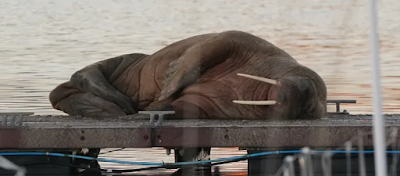A Walrus, Odobenus rosmarus, spent a day resting on a harbour in the town of Scarborough in North Yorkshire, England. The Animal first appeared at about 11.30 on Friday 30 December 2022, returning to the sea at about 4.00 pm on Saturday 31 December, by which time the town had cancelled it's annual New Year Eve firework display to avoid distressing the Marine Mammal on the advice of the wildlife charity British Divers Marine Life Rescue; although as a way of attracting visitors to the town, Walruses proved to be rather more successful than fireworks, with thousands of people arriving to witness the event. The Walrus is believed to be the same Animal spotted on the coast of Hampshire earlier in December, where he was given the nickname 'Thor'. It was spotted again on a wooden pontoon at Blythe on the coast of Northumberland, about 160 km north of Scarborough, on Monday 2 January 2022.
Walruses are the third largest species of Seal, exceeded only by Northern and Southern Elephant Seals (Mirounga angustirostris and Mirounga leonina), and are armed with a large and impressive set of tusks. As such they have few natural enemies, giving them a degree of self confidence surprising compared to most wild Mammals in the UK. Both Polar Bears (Ursus maritimus) and Orca (Orcinas orca) will on occasion hunt Walrus, but they are the preferred prey of neither species, due to their large and potentially dangerous nature. Walruses are also hunted by Humans to some extent, although today this activity is tightly regulated and Walrus products are listed on Appendix 3 of the CITES convention.
Walruses are, however still considered to be Vulnerable under the terms of the International Union for the Conservation of Nature's Red List of Threatened Species, due to the potential threat they face from a warming climate. The species is naturally found in the waters of the Arctic Ocean, around Greenland and Svalbard Island, and the northern coasts of Russia, Alaska, and Canada, where they feed on a wide variety of marine invertebrates, with a strong preference for Clams. These environments are considered to be particularly vulnerable to warming climates, which cause loss of the seasonal ice cover, lower the oxygen content of the water (cooler water can absorb and retain more dissolved oxygen than warmer water), and enable invasions by species from warmer climates. While occasional lone Walruses may venture southward (two Walruses where seen on the coasts of Europe in 2021, one in the Irish Sea and the other in the Baltic), it is doubtful that these environments produce enough food to feed a breeding population of these large Mammals, and doing so would almost certainly bring them into conflict with Human shellfish farmers and harvesters (notably, the Walrus seen in the Baltic in 2021 starved to death on the coast of Finland, despite efforts to rescue it).
See also...
Follow Sciency Thoughts on Facebook.
Follow Sciency Thoughts on Twitter.









